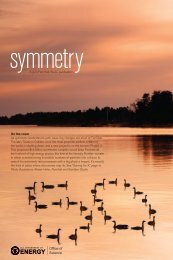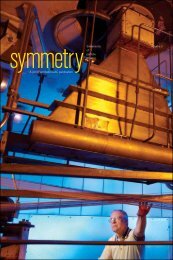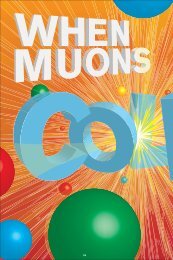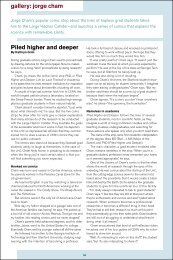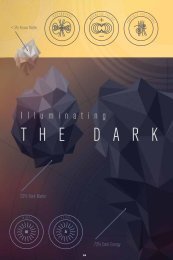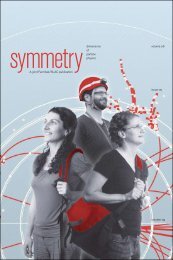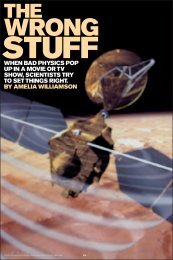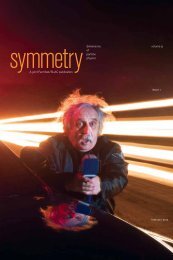Download Issue PDF - Symmetry magazine
Download Issue PDF - Symmetry magazine
Download Issue PDF - Symmetry magazine
Create successful ePaper yourself
Turn your PDF publications into a flip-book with our unique Google optimized e-Paper software.
When the LHC starts up, data will pour in fromup to 40 million particle collisions that occureach second in the CMS detector. A trigger system,which acts as a sort of spam filter, selectsonly the most interesting collisions, roughly 100per second, for further study. Even so, what’sleft is an overwhelming amount of data. Giantcomputer farms store this data, and physicistslater reassemble it into a form the human braincan grasp and analyze. Piecing the collisionstogether requires complex software with thousandsof lines of code. To discover anything new, physicistsmust be able to speak a common language—a computing language.That is where the starter kit comes in.“If you don’t have a simple way of getting peopleon the road, you lose them,” says Klima, who coleadsthe LPC Physics Forum, a weekly seminarfor young CMS scientists.Although the starter kit started as a USendeavor, it didn’t take long for all of CMS toembrace the idea and make it an official project.In fact, a Physics Analysis Tools group alreadyexisted for CMS, and the starter kit project fitright into its charge. The collaboration appointeda starter kit team, including Steven Lowettefrom the University of California, Santa Barbara;Elizabeth Sexton-Kennedy and Eric Vaanderingfrom Fermilab; and Petar Maksimovic andRappoccio from Johns Hopkins. Other CMS collaboratorshelped, too. “A lot of tools alreadyexisted,” Rappoccio says. “It was just a questionof putting things together in a user-friendly way.”The starter kit consists of a number of “buildingblocks” that recognize specific particles—forinstance, muons or electrons—coming out ofcollisions. Like templates for a Web page, theyallow the user to plug in information and generateimmediate results. Later, researchers cancustomize the computer code to suit their needs.Each building block comes with the collaboration’sguarantee that it will work.After testing the new tools on a few fellowphysicists, the team launched Starter Kit 1.0 at aCMS tutorial workshop for graduate studentsand postdocs in January. For now, physicists areusing the kit to analyze simulated data.The early reviews are positive.Malina Kirn, a graduate student at the Universityof Maryland, says she likes the kit because it’sa great way to start an analysis and “not worryabout mistakes.”Kevin Flood, a postdoc at the University ofWisconsin-Madison, describes the starter kitas satisfaction guaranteed: “It gives you a realsense of accomplishment.”The starter kit builds on a tradition of preparingpeople to dive into an experiment. At Fermilab,for example, the CDF and DZero collaborationsheld tutorials for newcomers. Klima recallsrecording DZero tutorials on videotape in the early1990s; some institutions even bought copies ofthe tapes for their users.ATLAS, the other gigantic detector at the LargeHadron Collider, also has a set of analysis toolsto get members started. Based on a handbookfrom the BaBar experiment at the StanfordLinear Accelerator Center, the ATLAS workbookintroduces experimenters to the detector’s softwareand describes basic analysis steps. Lastyear, ATLAS started another workbook dedicatedsolely to physics analysis.CMS also has a workbook, modeled on toolsthat ATLAS developed. Since both ATLAS andCMS have many members who used to work onBaBar, it’s natural for them to have similar softwaretools.Although the CMS team based parts of itsstarter kit on the workbook, they say it’s fundamentallydifferent because it was designed with theuser in mind. And while they originally developedthe kit for newcomers, it’s intended to becomea repository of CMS-certified code that’s usefulto anyone. A newcomer starts with the buildingblocks; a more experienced experimenter canuse the starter kit to test more complicated scenarios.“If you have an idea, you don’t want itto be months later before you find out if it works,’’Rappoccio says.Now that the starter kit is launched, the teamserves as the starter kit help desk. In additionto providing user support, they are adding moresophisticated physics tools for expert users. Infact, Kirn, who helped test-drive the kit, is alreadyworking on a more advanced set of tools.With the ever-evolving starter kit providing acommon language, physicists will be able tojump into the analysis of their mountains of dataright away, leading to quicker scientific resultsand, ultimately, a faster pace of discovery.symmetry | volume 05 | issue 01 | jan/feb 0811



